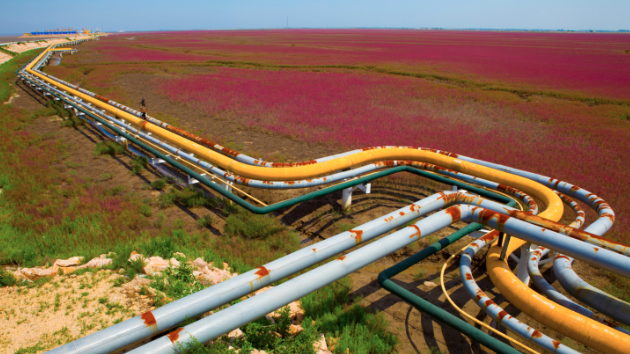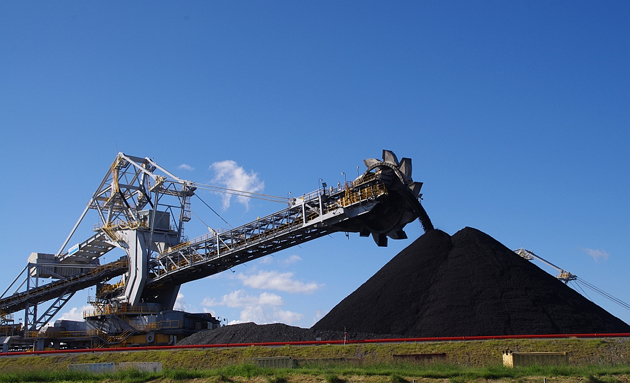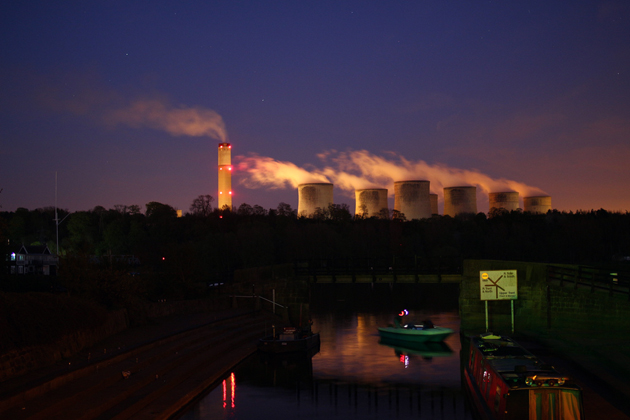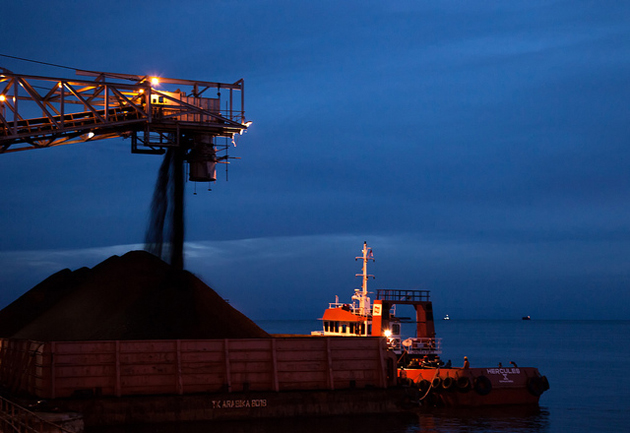This story was written by the Guardian‘s Suzanne Goldenberg. It was originally published in the Guardian and is reproduced here as part of the Climate Desk initiative. The video was produced by Climate Desk’s Tim McDonnell.
The massive block of steel towers and pipes rises out of the morning fog like a sci-fi fantasy. But this coal-fired power plant could help save the climate, or at least that’s the hope of the Obama administration.
The plant in east-central Mississippi was repeatedly invoked by the Environmental Protection Agency (EPA) to justify sweeping new climate change rules. When it comes online later this year, Kemper will be the first power plant in the US capable of capturing and storing carbon dioxide emissions.
The EPA says the Kemper County Energy Facility offers a real-life example that it is possible to go on burning the dirtiest of fossil fuels and still make the cuts in carbon dioxide emissions needed to avoid a climate catastrophe.
But with staggering costs—$5 billion and rising—and pushback from industry and environmental groups who say carbon capture is an unproven technology, now even the company that built Kemper is having second thoughts about the future of “clean coal”.
Meanwhile, Republicans in Congress are moving votes to overturn the entire set of EPA climate rules, based on the argument that carbon capture technology still does not work, and on Wednesday the house of representatives’ science committee is looking at CCS technology.
The 582 megawatt facility is expected to burn through around 4 million tonnes of low-grade lignite coal a year, all mined from the hills just behind the plant.
But the plant will strip out about two-thirds of carbon dioxide emissions, leaving emissions at about the same level as cleaner-burning natural gas, Southern Company said.
“The carbon footprint is essentially the same or maybe even less than a natural gas plant that doesn’t have carbon capture,” said Randall Rush, the Southern Company engineer who spent 25 years bringing the plant to life.
The diverted CO2, instead of going into the atmosphere, would be pumped to the Gulf Coast of Mississippi, and used by two Mississippi companies for enhanced oil recovery.
The EPA and other proponents of carbon capture and storage technology say projects like Kemper could help assure a future for coal under the EPA’s new climate change rules, outlined last September.
“It would be pretty hard to argue that this technology does not exist when it is standing there on 55 acres and many many stories towering above you,” said John Thompson, who heads the coal transition team for the Clean Air Task Force, one of the few environmental groups endorsing the technology.
The EPA rules are the main pillar of Barack Obama’s plan to fight climate change, by reducing the largest source of carbon dioxide emissions: the country’s power plants.
The proposed rules would limit future coal plants to 1,100 pounds of carbon dioxide emissions per megawatt hour of electricity. The average for current fleet of coal-fired plants is about 1,700 pounds.
The new standards would effectively require future coal-fired plants to capture and store a portion of the carbon dioxide they produce—just like Kemper.
The basic technology is not new, said Ian Yeates, who heads the carbon capture division at SaskPower, a Canadian firm which will deploy its own version of carbon capture later this year.
“This is not a moon shot. It is being done in lots of other industries that have nothing to do with electricity,” Yeates said. He said the oil industry has used carbon capture for years to prime failing oil fields.
But the economics are still not in favor of carbon capture, even with Kemper’s example, because of the high capital costs, industry analysts said. The cost of the plant has nearly doubled to more than $5 billion because of construction delays.
Industry and Republicans say the new EPA rules amount to a “war on coal.”
The EPA administrator, Gina McCarthy, insists the existence of Kemper and three other projects offer a lifeline for coal under the new climate change plan.
“Rather than killing future coal, [the new rules] actually sets out a certain pathway forward for coal to continue to be part of a diverse mix in this country,” she said when announcing the new standards.
But there are few takers for this view—even among those recruited to help the White House advance its climate change agenda.
“This technology is only just gaining maturity for power generation,” said Bill Ritter, a former Democratic governor of Colorado who is part of a taskforce advising the White House on clean energy.
“We are not saying CCS [carbon capture and storage] isn’t commercially viable, but it is unproven enough to not bank targets alone on this ,” Ritter said.
Southern has no interest in acting as the poster child for Obama’s new climate change regulations.
Behind the scenes, the company has moved to license the technology worldwide, hoping to sell its gasification and carbon capture technology to countries such as China, India, Pakistan and Poland which have reserves of low-grade lignite.
“We definitely see the Kemper County energy facility as a way forward to keep coal as part of a viable, energy mix,” Amoi Geter, a spokesperson for Mississippi Coal, a subsidiary of Southern, said during a tour of the plant. “It may not be the only way but it is definitely a way.”
But Southern, which relies heavily on coal at its other power plants in the south-east, has been outspoken in its opposition to the EPA’s new regulations – and the use of its plant to sell them to a skeptical industry and public.
“The revised new source performance standards would essentially eliminate coal as a future generation option,” Tim Lelejdal, a spokesman for Southern Company, wrote in an email.
He argued the Kemper plant was a one-off that made commercial sense only because the plant was close to coal fields and Southern had a market for the CO2.
“The location of the Kemper County Energy Facility – near its fuel source and existing CO2 pipelines – makes the plant the right choice for Mississippi and other places with common characteristics,” Leljedal wrote. “The Kemper County Energy Facility should not serve as a primary basis for new emissions standards impacting on all new coal-fired power plants.”
Even before the prospect of new climate change regulations, the US coal industry was being clobbered by the competition from cheap natural gas.
About 150 coal-powered plants have shut down since 2010. Because of the high capital costs, there are only three other carbon capture projects under development in the US. “If natural gas is readily available in enormous quantities at the price that it is available now no-one would ever build another coal plant on this planet,” Rush said.
Meanwhile, environmental groups see carbon capture as an industry figleaf to shield the EPA from pushback against its climate rules that will still allow the use of fossil fuels, albeit with lower emissions.
“It’s expensive, it’s dirty, and it’s unnecessary,” said Louie Miller, director of the state Sierra Club.
In Miller’s view, carbon capture technology just perpetuates the use of fossil fuels – and dangerously delays the transition to renewable energy.
He said Southern had no real interest in pioneering carbon capture technology, and had exploited federal government grants to advance its proprietary gasification technology.
“It was never about carbon capture and sequestration. The only thing this has been about is getting federal money to jump start this project.”
The company has received some $700 million in federal grants and tax credits, and has been authorized to recover at least $2.8 billion of Kemper’s costs by increasing utility rates—in one of the poorest areas of the country.
Those numbers alone should put people off Kemper and the notion of clean coal, Miller said.
“When you have got everybody from Warren Buffet to the Sierra Club saying that the future of coal is pretty much dead on arrival, it doesn’t matter whether Kemper actually does what it is being billed to do,” he said. “Long term, it doesn’t matter in the big scheme of things.”
















